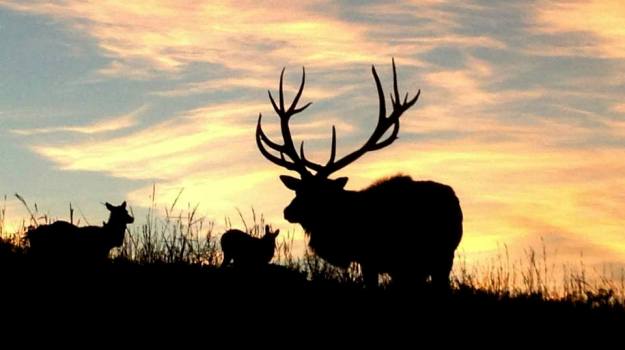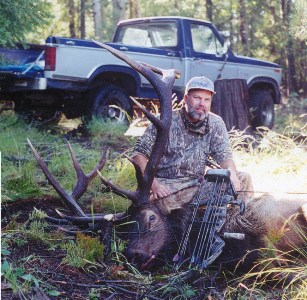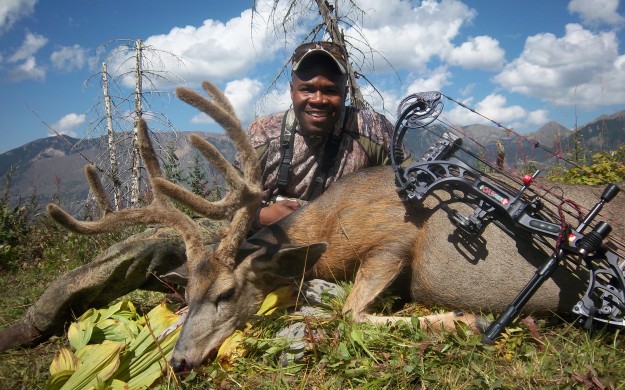Mark Hanson’s Biggest Arizona Bull Elk was 368 Points

Editor’s Note: Many western states have archery hunts for elk, mule deer and whitetails that begin from mid-August through September. While many easterners are riding the waves and getting suntans at the beach, western archers are climbing mountains or hunting from tree stands. Mossy Oak Pro Mark Hanson lives in Mesa, Arizona, and starts bowhunting not far from his home as soon as the season opens in Colorado. He purchases a rifle tag for cow elk and hunts with a bunch of his buddies. Hanson has been hunting elk and mule deer since the early 1980s and has taken nine bulls and 15 cows with his rifle. Occasionally he hunts mule deer, but he's taken more Coues whitetails than he has mule deer. He's on the PSE Pro Staff and currently shoots the PSE Evolve 35 bow. He has been a Mossy Oak Pro for the last 10 years.
The biggest bull elk I’ve ever taken scored 368 points. I took him in 1999 on the eastern side of Arizona in Unit 27, right on the Arizona/New Mexico border and directly across from the Gila National Forest. I've been hunting this area since 1990, and I've taken a number of bulls from that unit. Even for an archery hunter, this is a tough unit to draw, especially during the rut. When I first started hunting this region, I drew tags four out of five years. Then I had a dry spell for a while. But finally, I drew a tag again in 1999. I knew the unit really well. Although this unit was very thick and homed numbers of canyons, it wasn’t a great place for traditional hunting where you sit, glass elk and then call the elk in to where you set up.
I saw the bull that I took before the season opened, and felt I had him patterned. I was 8,500-9,000 feet high in the mountains. The first day I hunted him in September, we played cat-and-mouse for a while. Then a rain and hail storm moved in and shut down my hunting for the day. The next morning, I went to the spot on a trail where I had seen him with his cows before the season. This was one of the easiest bulls I'd ever taken out of this unit. I actually shot the bull about 100 yards from a logging road, and he went down less than 50 yards from it.
The bulls were bugling at that time of year, and I had set up camp between two meadows. I got very little sleep the first night, because bulls were bugling in both meadows all night long. I knew that as daylight approached, the bulls usually moved out of the meadows and went up a mountain on either side of the meadows that both funneled down into a wilderness area.
Before daylight, I set up on the ridge on the trail I thought the bull and his cows would take that led down into the wilderness area. This bull had several satellite bulls following him and his harem. As the sky brightened up, I heard the bull bugle as he started coming up the trail on the opposite side of the ridge where I was hunting. I quickly moved about 100 yards up the trail the bull and his cow were coming on, set up and prepared for the shot.
 While I waited, I remembered back to the week before the hunt when my son and I were in this same area. We had set up at the same campsite early in the morning, and we heard this bull bugling. So, we walked from camp to try and find a spot to set up where we might be able to watch him. When we reached the top of the ridge he was on, I looked over the edge of the ridge and saw the cows that were with him. Before I had spotted the cows, 75 yards to the right, I’d seen this bull raking a tree with his antlers. He didn’t know that my son and I were on that ridge, and we watched the elk for 30 minutes. I could tell the bull was very heavy, had a good mass on his rack and was a main frame 6x6, where on the end of his rack he had about a one-inch kicker point that made him a 7x6.
While I waited, I remembered back to the week before the hunt when my son and I were in this same area. We had set up at the same campsite early in the morning, and we heard this bull bugling. So, we walked from camp to try and find a spot to set up where we might be able to watch him. When we reached the top of the ridge he was on, I looked over the edge of the ridge and saw the cows that were with him. Before I had spotted the cows, 75 yards to the right, I’d seen this bull raking a tree with his antlers. He didn’t know that my son and I were on that ridge, and we watched the elk for 30 minutes. I could tell the bull was very heavy, had a good mass on his rack and was a main frame 6x6, where on the end of his rack he had about a one-inch kicker point that made him a 7x6.
When I first saw the bull coming behind the herd of cows on the second day of my hunt, I was able to identify him as the bull that my son and I had seen. I noticed he’d broken off that small kicker point on the end of his rack. I was 20 yards off the trail and decided not to call to the bull and the cows that were coming down the trail toward me. Then the lead cow stopped and looked at me for a second. But one of the cows behind her pushed her with her nose, making the lead cow continue to walk on down the trail.
As soon as I saw the bull 27 yards away, I already had drawn my bow. I was kneeling down and laid my bow at full draw on my knees. To get off a shot, I simply had to bring the bow up, look through my peep sight for the place I wanted to put and release the arrow. I aimed at an opening that I was confident the bull would walk through, but he stopped and took a step forward. I released the arrow and hit him right behind his shoulder, mid-body. As he ran off, I bugled to him. However, he was out of sight. I waited about 30 minutes. Then I started following the blood trail. I hadn’t gone very far before I spotted him down on the other side of the mountain.
He carried a lot of mass on his rack, and the circumference of each one of his main beams was 7-1/2 inches - almost to the tips of his antlers. He gross-scored 368 and netted 360. Although he was a really fine bull, what I was most excited about was that he had fallen only 25 yards from a logging road I could get my truck to, which made skinning and quartering him and taking the meat and head to the truck the easiest bull I'd ever loaded up.
To get John and Denise Phillips’ free cookbook, “Miz Denise’s Outdoor Cooking: More Than 35 Recipes for Elk and Mule Deer,” go to http://johninthewild.com/free-books.
Tomorrow: My Latest Bull Elk with Pro Mark Hanson






























